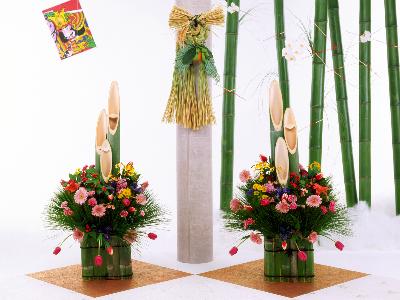|
The custom of 'kadomatsu' door decoration has been popular all over Japan since olden times.
Kadomatsu are placed in front of houses to welcome the New Year deity, purify the entrance and drive demons and evil spirits out. Originally, they were made from evergreen woods such as pine, cedar, beech and sakaki. But the prevalence of the use of pine has led to their naming as 'kadomatsu' ('gate pine').
'Pine lasts for 1000 years and bamboo for 10,000 years' is an old Japanese proverb. Pine and bamboo are popular materials for kadomatsu because people wish that Yorishiro, the place in which the deity lives, will last forever.
According to custom, kadomatsu should not be set up on 31st December. This is because it is not faithful to have only one day before welcoming the deity on New Year's Day. Moreover, the 29th should also be avoided because 'nine matsu' is the same pronunciation as 'wait for pain'. Usually, kadomatsu are set up by the 28th.
Kadomatsu are placed in front of houses to welcome the New Year deity, purify the entrance and drive demons and evil spirits out. Originally, they were made from evergreen woods such as pine, cedar, beech and sakaki. But the prevalence of the use of pine has led to their naming as 'kadomatsu' ('gate pine').
'Pine lasts for 1000 years and bamboo for 10,000 years' is an old Japanese proverb. Pine and bamboo are popular materials for kadomatsu because people wish that Yorishiro, the place in which the deity lives, will last forever.
According to custom, kadomatsu should not be set up on 31st December. This is because it is not faithful to have only one day before welcoming the deity on New Year's Day. Moreover, the 29th should also be avoided because 'nine matsu' is the same pronunciation as 'wait for pain'. Usually, kadomatsu are set up by the 28th.
| [+ADDRESS] | 
|













